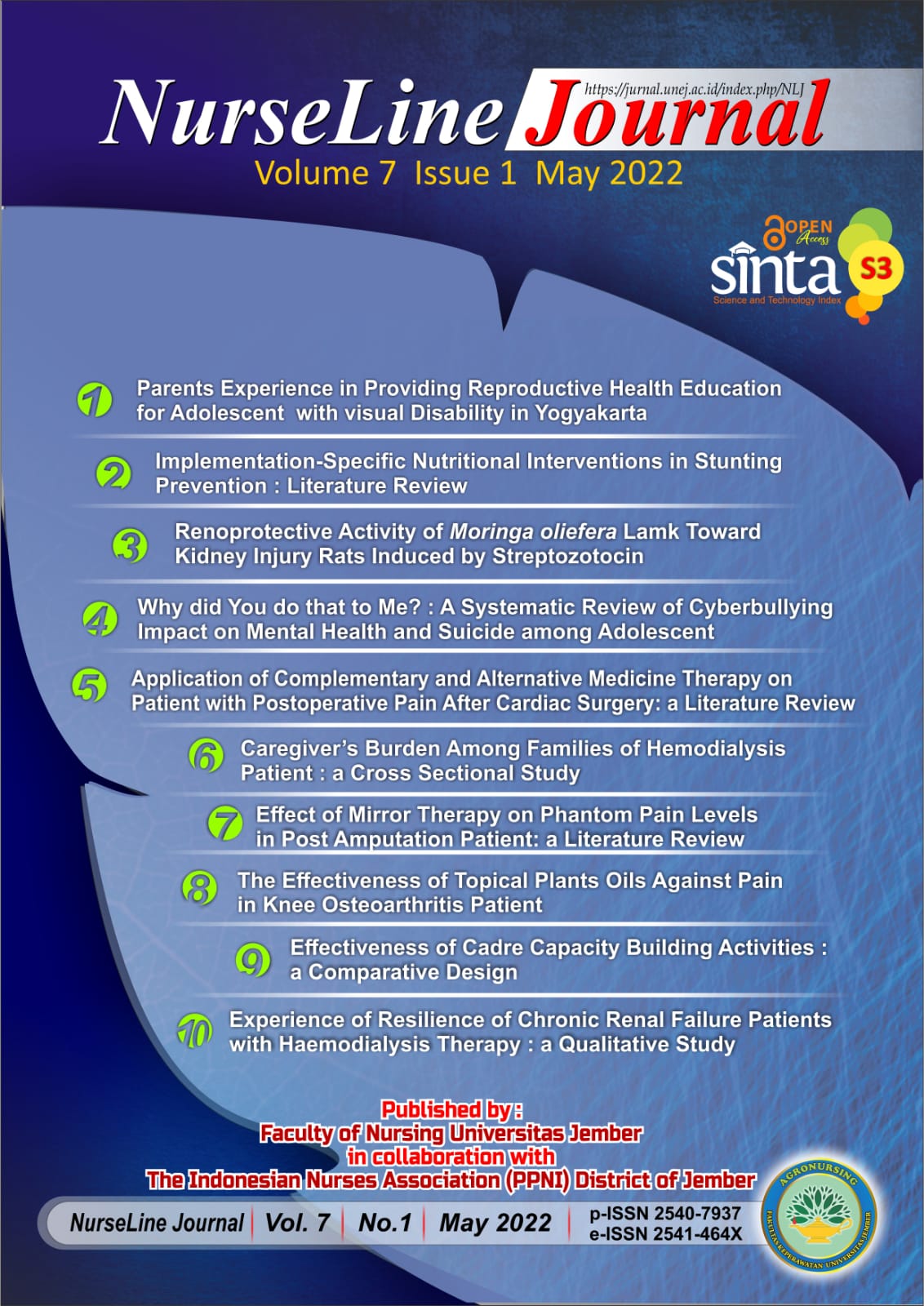Effect of Mirror Therapy on Phantom Pain Levels in Post Amputation Patient: a Literature Review
DOI:
https://doi.org/10.19184/nlj.v7i1.29870Keywords:
Amputation, Mirror therapy, Phantom painAbstract
Background: Phantom pain after amputation is ordinary. Phantom pain is challenging to treat, so it will last a long time which will cause depression and anxiety and reduce the quality of life. There are various treatment options: pharmacological (antidepressants, anesthetics) and non-pharmacological (acupuncture, hypnosis). However, there is still no proven effective therapy, so it is necessary to try a non-pharmacological therapy that is safe, cheap, and easy, namely mirror therapy. Purpose: This study aims to determine how the effect of mirror therapy on the phantom pain of post-amputation patients. Methods: Narrative literature review of a publication registered 2017-2021 on Pubmed, ProQuest, EBSCO, and Google Scholar. Search articles using the keywords" amputation," and " phantom pain," and "mirror therapy." This study uses inclusion criteria consisting of patients who experience phantom pain, research in the form of mirror therapy intervention, there is comparison, the study design uses a randomized controlled trial and case report, with results explaining the effect of mirror therapy in Indonesian or English, and indexed by SINTA or SCIMAGO. Results: 8 articles were included in the inclusion criteria. The majority of articles had a randomized controlled trial design of 7 articles and a case report of 1 article. Four articles discuss mirror therapy, and the other four articles discuss mirror therapy with other therapies. Respondents have an age range of 15-82 years, and most are male. Conclusion: Mirror therapy is recommended to be carried out routinely and according to procedures for post-amputation patients. It has been proven to reduce pain scales in patients before and after the intervention. Nurses can use mirror therapy in the client care process during the post-amputation rehabilitation process.
Downloads
References
Bang, M. S., dan S. H. Jung. 2020. Phantom Limb Pain. Elsevier Inc.
Barbara, L. 2020. Systematic Review Dalam Kesehatan: Langkah Demi Langkah. Yogyakarta: Deepublish
Collins, K. L., H. G. Russell, P. J. Schumacher, K. E. R. Freeman, E. K. O’Conor, K. D. Gibney, O. Yambem, R. W. Dykes, R. S. Waters, dan J. W. Tsao. 2018. A Review of Current Theories and Treatments for Phantom Limb Pain. Journal of Clinical Investigation. 128(6): 2168-2176.
Dinas Kesehatan Pemerintah Kota Yogyakarta. 2019. Profil Kesehatan Tahun 2019.
Faure, C., A.Limballe, dan H. A. Kerherve. 2019. Fooling the Brain, Fooling the Pain: the Role of Mirror Therapy and Modern Uses in Virtual Reality. Frontiers for Young Minds. 7: 1-6
Finn, S. B., B. N. Perry, J. E. Clasing, L. S. Walters, S. L. Jarzombek, S. Curran, M. Rouhanian, M. S. Keszler, L. K. H. Andersen, S. R. Weeks, P. F. Pasquina, dan J. W. Tsao. 2017. A Randomized, Controlled Trial of Mirror Therapy for Upper Extremity Phantom Limb Pain in Male Amputees. Frontiers in Neurology. 8: 1-7.
Fuchs, X., H. Flor, dan R. B. Bodmann. 2018. Psychological Factors Associated with Phantom Limb Pain: A Review of Recent Findings. Pain Research and Management. 1-12.
Gunduz, M. E., K. Pa. Brarrios, C. B. Pinto, D. Duarte, F. G. S. Veelez, A. Caroyna L. Gianlorenco, D. Crandell, L. R. Battisella, M.l Simis, dan F. Fregni. 2021. Effects of Combined and Alone Transcranial Motor Cortex Stimulation and Mirror Therapy in Phantom Pain: A Randomized Factorial Trial. Neurorehabilitation and Neural Repair. 35 (8): 704-716.
Hanna, E. Morbid Curiosity? Discussion of the Disposal of Amputated Limbs on Online Question and Answer Sites. Digital Health. 5:1-12.
Hermanto. 2021. Terapi Cermin (Mirror Therapy) dalam Asuhan Keperawatan Strok. Malang: Ahlimedia Book.
Jorge, M. 2019. Etiology of Amputation. Edisi 4. Amsterdam: Elsevier Inc.
Kementerian Kesehatan Republik Indonesia. 2016. Keperawatan Gerontik.
Kern, U., V. Busch, M. Rockland, M. Kohl, dan F. Birklein. 2009. Prevalence and Risk Factors of Phantom Limb Pain and Phantom Limb Sensations in Germany: A Nationwide Field Survey. Schmerz. 23(5): 479-488.
Kulunkonglui. B. A., F. Erbahceri, A. Alkan. 2019. A Comparison of the Effect of Mirror Therapy and Phantom Exercise on Phantom Limb Pain. Turkish Journal of Medical Science. 49(1): 1010-109
Limakatso, K., G. J. Bedwell, dan R. Parker. 2020. The Prevalence and Risk Factors for Phantom Limb Pain in People with Amputations: A Systematic Review and Meta Analysis. PLoS ONE. 15(10): 1-21.
Maduri, P, dan H. Akhondi. 2021. Upper Limb Amputation. Progress in Surgery. 16: 224-248.
Mallik, A. K., S. K. Pandey, A. Srivastava, S. Kumar, dan A. Kumar. 2020. Comparison of Relative Benefits of Mirror Therapy and Mental Imagery in Phantom Limb Pain in Amputee Patients at a Tertiary Care Center. Archives of Rehabilitation Research and Clinical Translation. 2(4)
Ol, H. S, Y. V. Heng, L. Danielsson, dan H. Husum. 2018. Mirror Therapy for Phantom Limb and Stump Pain. Scandinavian Journal of Pain. 1-8.
Petrini, F. M., G. Valle., M. Bumbasirevic., F. Barberi., D. Bortolotti, P. Cvancara, A. Hiairassary, P. Mijovic, A. O. Sverisson, A. Pedrocchi, J. L. Divoux, I. Popovic, K. Letchler, B. Mojivic, D. Guiraud, T. Stieglitz, A. Alexandersson, S. Micera, A. Lesic, dan S. Raspopovic. 2019. Enhancing Functional Abilities and Cognitive Integration of the Lower Limb Prosthesis. Science Translational Medicine. 11 (512): 1-13.
Pratama, A. D. 2018. Penatalaksanaan Fisioterapi pada Kasus Post Amputasi Transtibial Sinistra Akibat Chronic Limb Ischemia di RSPAD Gatot Soebroto. Jurnal Vokasi Indonesia. 6(2): 33-40.
Ramadugu, S., S. C. Nagabushnam, N. Katuwal, dan K. Chatterjee. 2017. Intervention for Phantom Limb Pain: A Randomized Single Crossover Study of Mirror Therapy. Indian Journal of Psychiatry. 59(4): 2017-2018.
Redho, A., Y. Sofiani, dan A. W. Warongan. 2019. Pengaruh self Healing terhadap Penurunan Skala Nyeri Post Op. Journal of Telenursing. 1(1): 2015-214
Rothgangel, A. 2019. Treating Phantom Limb Pain. Enschede: Gildeprint.
Rothgangel, A., S. Braun, B. Winkens, A. Beurskens, dan R. Smeets. 2018. Traditional and Augmented Reality Mirror Therapy for Patients with Chronic Phantom Limb Pain (PACT Study): Results of a Three-group, Multicentre Single-Blind Randomized Controlled Trial. Clinical Rehabilitation. 32(1): 1591-1608.
Sahu, A., R. Sagar, S. Sakar, dan S. Sagar. 2016. Psychological Effects of Amputation: A review of Studies from India. Industrial Psychiatry Journal. 25(1): 4.
Sin, E. I. L., S. Y. Thong, dan K. H. Poon. 2013. Incidence of Phantom LimbPhenomena After Lower Limb Amputations in a Singapore Tertiary Hospital. Singapore Medical Journal. 54(2): 75-81.
Nitza Segal, N., D. Put, H.Amir, M. Ratmansky, P. Kuperman, L. Honingman, dan R. Treister. 2020. Addictive Analgesic Effect of Transcranial Direct Curent Stimulation Together with Mirror Therapy for Treatment of Phantom Pain. Pain Medicine. 22(2): 255-265.
Sitompul, Y., B. Budiman, S. Soebardi, dan M. Abdullah. 2015. Profil Pasien Kaki Diabetes yang menjalani Reamputasi di Rumah Sakit Cipto Mangunkusumo Tahun 2008-2012. Jurnal Penyakit Dalam Indonesia. 2(1): 9-14.
Spoden, M., U. Nimptsch, dan T. Mansky. 2019. Amputation Rates of the Lower Limb by Amputation Level-Observational Study using German National Hospital Discharge Data from 2005 to 2015. BMC Health Services Research. 19 (8): 1-9.
Syaifuddin, M. 2016. Hubungan Panjang Puntung dan Indeks Massa Tubuh dengan Keseimbangan Berjalan pada Pasien Pasca Amputasi Anggota Gerak Bawah. Momentum. 12(2): 13-16.
Trevelyan, E. G., W. A. Turner, dan N. Robinson, 2015. Acupunture for the Treatment of Phantom Limb Pain in Lower Limb Amputees: Study Protocol for A Randomized Controlled Feasibility Trial. Trials. 16(1):1-8.
Ukibe, S. N., N. R. Ukibe, A. C. O. Okaro, J. Ekezie, C. U Okeke, dan C. T. Onyeanusi. 2016. Epidemiology and Pattern Limb Amputation in Owerri Orient Journal of Medicine. 28(1): 17-21.
Urits, I., D. Seifert, A. Seats, S. Giacomazzi, M. Kipp, V. Orhurhu, A. D. Kaye, dan O. Viswanath. 2019. Treatment Strategies and Effective Management of Phantom Limb Associated Pain. Curent Pain and Headache Reports. 23(64):1-7.
Winardi, W., dan R. A. Musak. 2021. Literature Review: Panduan Riset Kesehatan dan Keperawatan. Pekalongan: NEM.
Yaputra, F., dan I. P. E. Widyadharma. 2018. Management of Phantom Limb Pain: a Review. International Juornal of Medical Reviews and Case Reports.
Yildirim, M., dan S. Ken. 2020. Mirror Therapy in the Management of Phantom Limb Pain. The American Journal of Nursing. 120(3):41-46.
Yoo, S., M. Keszler, dan Z. Petrin. 2018. Amputation Related Pain. Elsevier Inc.
Zaheer, A., A. N. Malik, T, Masood, dan S. Fatima. 2021. Effects of Phantom Exercises on Pain, Mobility, and Quality of Life Among, Lower Limb Amputees: A Randomized Controlled Trial. BMC Neurology. 21(1): 1-9.








